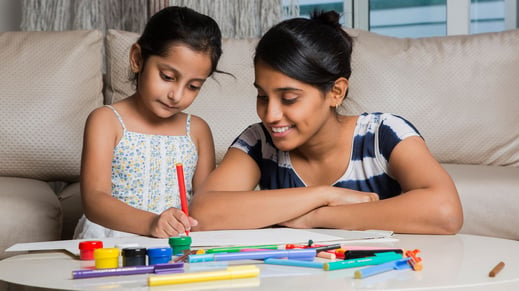
The aim of instructional support is to provide teachers with instructional strategies that assist and improve child-teacher interactions. Why? Because research shows that interactions between students and adults are a primary mechanism for promoting student development and learning.
Therefore, by learning instructional support strategies and improving interactions, teachers are better able to support student success.
But that doesn’t happen overnight. Small, incremental changes in teacher practices are what result in measurable increases in child learning outcomes, like greater social and academic gains over time.
From learning how to better understand a child’s learning style to selecting and adapting learning materials to meet student needs, there are many instructional strategies that will help to deliver better learning outcomes within the classroom.
What are the Essentials of Instructional Support?
If you feel lost in the fog of instructional support, you’re not alone. There is no magic formula for improving child-teacher interactions. Many of us didn’t encounter great Instructional Support when we were young students ourselves, either. So it’s no wonder Instructional Support can feel challenging and confusing!
The questions teachers often ask is how they can improve the quality of their interactions around Instructional Support.
The simple answer? By focusing on the HOW.
By focusing on the “HOW” of your interactions, you’re able to learn better strategies and techniques for how you create more positive student outcomes through:
- Improved Emotional Support. This means exhibiting behaviors such as warmth, positive communication, and sensitivity to children’s needs.
- More Effective Classroom Management. This includes the ways you optimize learning opportunities and maintain and build interest in learning within the classroom.
Three dimensions that act as a springboard for improving in these areas, outlined in depth in our article on ‘How to Improve Your Instructional Support Interactions’, include:
- Teacher Sensitivity. Teacher Sensitivity is not about being “nice” or “caring”. Rather, it is about how a teacher effectively responds to children’s current academic and emotional abilities and needs. By providing helpful feedback based on observation and a strong understanding of children’s challenges with a particular task or concept, a teacher is better able to improve overall student outcomes.
- Instructional Learning Formats. In order to maximize student engagement (especially in a world where attention spans are diminishing), providing students with a variety of Instructional Learning Formats helps improve their ability to learn. By being involved, actively commenting on student work and asking relevant questions, teachers are able to actively set the stage to facilitate children’s engagement and encourage students’ excitement.
- Regard for Student Perspectives. This entails leaving room for including student ideas throughout the day. More on that below.
How Does Regard for Child Perspectives Impact Instructional Support?
A particular strategy that is often misunderstood, but can deliver powerful outcomes when implemented, is Regard for Student Perspectives. Considered a domain within the Emotional Support dimension of CLASS, Regard for Student Perspectives (RSP) is defined as:
“The degree to which the teacher's interactions with students and classroom activities place an emphasis on students' interests, motivations, and points of view and encourage student responsibility and autonomy.”
In simpler terms? Regard means being comfortable letting go of a strict step-by-step curriculum and instead leaving room for incorporating ideas offered by students throughout the day. So whether you are a CLASS-trained educator or not, RSP is an effective instructional strategy for improving your classroom interactions.
But understanding how to effectively use Regard for Student Perspectives while managing everything else as a teacher (like a constructive learning environment) can be challenging.
Children want to know how the world works, how it fits together, and how that affects their perception of things. They’re curious! In order for them to make sense of the big world around them, the things they’re learning need to connect to things they already know, and what they’re interested in.
That’s where Regard comes into play. When teachers purposefully make room for student’s ideas in activities and lessons throughout the day, they create an intentional learning environment. This connects learning more to what they know and are interested in, allowing children to feel like they have a welcomed place in the classroom.
There are 4 key areas to focus on when it comes to Regard:
- Flexibility and Student Focus. Simply put, this means ensuring the student plays a role in developing the day! Whether that’s incorporating the student's ideas into the planned lesson, or going along with student interest when it doesn’t disrupt the lesson plan.
- Student Expression. This is about showing genuine interest in how each the students sees and interprets the world, and subsequently encouraging them to express these thoughts.
- Support for Autonomy and Leadership. Here, it’s about allowing students to be as independent and autonomous as possible, in order to give them more responsibility during an activity. What may begin as a specific teacher-directed activity can transform into a student-led activity.
- Restriction of Movement. This doesn’t mean keeping kids locked into one position all day long (obviously!), instead it’s about setting clear behavior and movement expectations for the specified activity.
At our recent InterAct Now: Teacher Summit, I presented with Marilyn Rice on how the CLASS dimension Regard for Child/Student Perspectives relates to the domain of Instructional Support.
From understanding more thoroughly how to observe and respond to student expression, as well as the role of language and communication in the realm of Regard, you’ll learn effective techniques for improved instructional support.
Watch the free recording to learn more about this important dimension and how you can use Regard to create better student outcomes in your classrooms.
